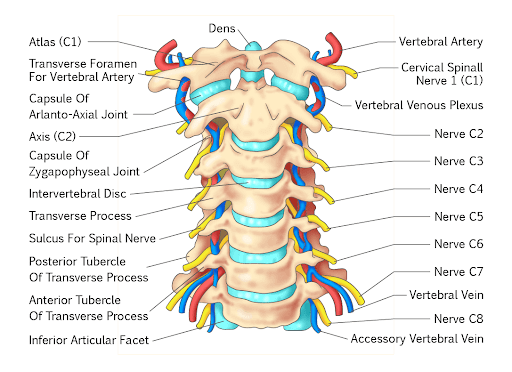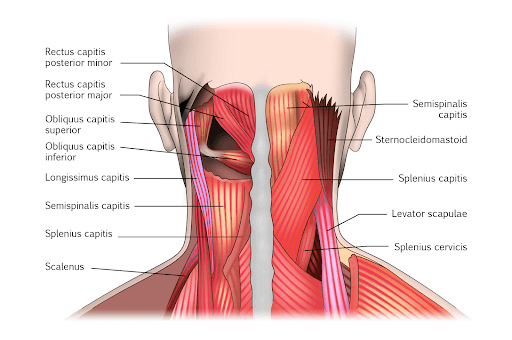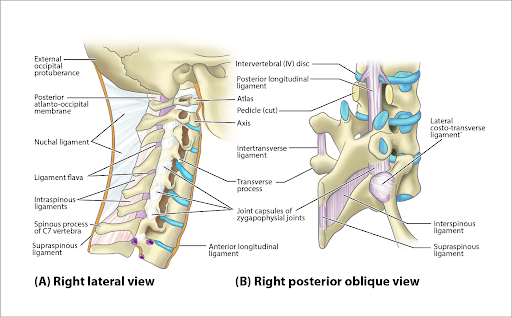Pain At The Base Of The Neck
Get Help With Pain At The Base Of The NeckPain at the base of the neck is the fourth most common cause of disability. It is important to understand the cause of the pain because it determines what treatment you need. While most pain at the base of the neck resolves without treatment, 50% of patients tend to have lingering symptoms and need to address the specific cause.
This post outlines all the facts about pain at the base of your neck.
Are you a Candidate?
Where In The Base Of The Neck Does It Hurt?
To understand what is causing pain in the base of the neck, it is important to understand the anatomy of the neck. The nerves, muscles, and ligaments can all cause the pain. Each of these are listed below:

Nerves
The cervical nerves emerge from the cervical vertebrae, and are labeled C1 to C8. Nerves at the base of the neck emerge from the C5 level and downwards. Any compression of these cervical nerves as they exit the spinal canal can cause neck pain at the base of the neck.
Many of these nerve roots branch further to supply the upper back and arm. The neck pain may radiate to the upper back and arm based on which nerve is compressed.
Muscles
The muscles of the base of the neck originate from the skull and insert down at the cervical spine and the shoulders, and include the levator scapulae, scalene, and splenius capitis muscles, sub occipital muscle group, etc. If there is a tear or injury to any of the muscles at the base of the neck, then pain at the base of the neck can develop.


Ligaments
The main ligaments of the cervical spine are the anterior longitudinal ligament, the posterior longitudinal ligament, supraspinous and interspinous ligaments, along with many others. Microtears or full-thickness tears can cause pain at the base of the spine. These tears can occur due to whiplash injuries or other traumatic incidents. These tears can occur from microtrauma over time as well.
Symptoms Accompanying Pain At The Base Of The Neck
Along with pain at the base of the neck, you may also experience other accompanying symptoms listed below:
Localized, Sharp, Stabbing Pain
A person may experience sharp, stabbing pain that is localized to the area where the injury, nerve compression, or cause of the pain has occurred. This pain can be very intense and the area may also be tender on palpation.
Localized pain points to the cervical vertebrae that are affected so if you have pain in the area supplied by C5, then you will experience localized pain in just that area, sparing the rest of the arm.
Widespread Dull Pain
Instead of localized pain, there may be generalized pain over the entire base of the neck and upper shoulder. The pain may even refer to the arm due to the nerve supply coming from the nerve roots of the cervical spine.
Numbness And Stiffness
Numbness may be present when the nerve roots are compressed. This is sometimes accompanied by tingling or a change in sensation along the skin. Stiffness at the base of the neck may also be present if there is inflammation within the spinal canal or in the cervical facet joints. Inflammation can be caused by infection, osteoarthritis, and other types of inflammatory arthritis.
Causes Of Pain At The Base Of The Neck
There are many causes of pain at the base of the neck. Here is a list of some possible causes:
Injuries
Whiplash injuries and other traumatic incidents that can stretch the ligaments, tendons, nerves, and shear muscles that may cause base of the neck pain. This usually occurs due to the sudden hyperextension and flexion of the neck at extremely high speeds, which can damage both the bones and the supporting structures at the base of the neck, leading to pain.
Nerve Compression
Nerve compression of any of the nerve roots as they exit the spinal canal can cause pain at the base of the neck. The compression could be due to degeneration of the intervertebral discs, disc herniation, bony spurs, or any tumor in the spinal canal. Nerve compression can cause pain and a change in sensation in the areas the nerve supplies. The occipital nerve can be compressed in tight muscles as well causing pain.
Muscle Strain
Straining the neck muscles can lead to pain at the base of the neck. This is commonly seen in individuals who work for many hours sitting down with a forward head position, causing the shoulders to droop.
When held for prolonged periods, this posture can overload the cervical spinal muscles, causing pain. The strain of the cervical muscles is also seen in those who perform repetitive overhead activities, which can lead to microtears in the muscles.
Worn Joints/Osteoarthritis
With age, the cervical joints get worn down, and the intervertebral disc degenerates. This leads to pain on movement every time the cervical facet joints or the cervical spine moves. The loss of the disc can also cause the joints to experience friction with movement, leading to pain at the base of the neck. It is very commonly seen with cervical facet joints in older individuals.
Inflammatory Arthritis
Inflammatory arthritis is an inflammatory condition such as rheumatoid arthritis where the bones or synovium of the joints are attacked by inflammatory cells of the body. Due to the inflamed joints, patients experience base of the neck pain. This pain commonly worsens with movement.
Meningitis
Meningitis is the inflammation of the meninges, the protective covering of the spinal cord and the brain. It occurs due to infection by bacteria, viruses, fungi, or mycobacteria. When the meninges are inflamed, it usually coincides with fever, neck stiffness, and pain at the base of the neck.
Fibromyalgia
Fibromyalgia is a condition characterized by musculoskeletal pain and fatigue. In fibromyalgia, the muscles of the neck receive less blood supply and hence less oxygen. This leads to pain in the muscles at the base of the neck.
However, in patients with fibromyalgia, the pain is not just limited to the base of the neck, but can occur simultaneously in many other muscles and joints of the body.
Spondylolisthesis
Spondylolisthesis occurs from degeneration of the spine. The combined facet joint and disc degeneration causes the vertebral body to move forward. The degenerated vertebral body slips anteriorly (anterolisthesis) or posteriorly (retrolisthesis) onto the vertebral body below it. Pain at the base of the neck can result, caused by compression of the exiting nerve roots or compression of the spinal cord itself.
Spinal Tumor
Primary tumors that arise in the spine, or metastases from other organs to the cervical spine, can cause pain at the base of the neck. Pain from a spinal tumor can occur when the tumor grows inside the vertebral body. As it expands, the bone cortex gets thinner, which can lead to a fracture.
Initially, the pain is due to the stretched periosteum (lining of the bone). If a fracture develops, the pain is due to compression of the nerves due to the expanding tumor.
When To See A Doctor About Pain At The Base Of The Neck
If you experience the following symptoms, then you need to get your neck examined by your doctor:
- Pain at the base of the neck that lasts more than six weeks
- Pain that is severe, unrelenting, or that is worsening
- Neck stiffness accompanying the neck pain
- Fever and chills
- Dizziness or vertigo
- Any swelling in the neck
- Decreased range of motion
Are you a Candidate?
Risk Factors
Certain risk factors can predispose you to pain at the base of the neck. A few of them are listed below:
- Stress: There is a strong relationship between stress and neck pain. Chronic stress activates the stress response and stimulates the release of cortisol. Repeated stress can cause cortisol dysfunction and lead to tissue degeneration in the neck area, leading to pain. This is just one of the proposed mechanisms for how stress can cause neck pain.
- Smoking: Smoking accelerates the degeneration of the intervertebral discs of the spine. This can lead to the base of the neck pain if the cervical spine is affected.
- Poor Posture: It has been documented that a forward head posture commonly seen in people who work on computers for long hours often results in pain at the base of the neck (1).
This is because the neck muscles and ligaments must work harder and for a longer period to support the head in this position against gravity. Over time, the muscles and joints become overloaded, and pain ensues.
- Sleeping Position: Sleeping posture is important. The best sleeping position is where the natural spinal curvature is maintained – in a supine position with the hands by the side, or lying on the side.
In other positions, the scalene muscles which contribute to the forward translation of the cervical vertebrae cannot balance the extensor muscles of the neck, the trapezius muscles. These muscles may become strained over time, leading to the base of the neck pain.
- Repetitive Movements: Occupations and sports that involve repetitive overhead motion like tennis and basketball are more prone to pain at the base of the neck. This could be due to inflammation or microtears in the muscles and ligaments associated with the base of the neck.
Common At-Home Treatments For Pain At The Base Of The Neck
If you are experiencing pain at the base of your neck, here are some treatment options you can try at home:
- Rest: Rest your neck. If you spend hours working at a desk or straining your neck muscles, then take a break for a few days and allow the structures in the neck to recover. Additionally, avoid activities and sports that jerk or move the neck suddenly.
- Ice/Heat: Alternating cold and heat therapy can be used for neck pain. Ice can reduce the pain caused by inflammation by reducing blood supply, while heat will dilate the blood vessels and allow more blood flow to the area and relieve pain.
- OTC Pain Relievers: Over-the-counter (OTC) pain relievers, like acetaminophen and ibuprofen, can reduce inflammation and provide pain relief. You can take these medications after a meal if heat and cold therapy do not help.
- Stretching: If your base of the neck pain is due to poor posture or strained muscles, then gentle neck stretching exercises for four weeks can reduce the base of neck pain and improve the functional movement of the neck.
Alternative Treatments For Pain At The Base Of The Neck
Various treatments for pain at the base of the neck in alternative medicine exist and have helped many people. Some of them are listed below.
- Acupuncture: This is a form of alternative medicine where fine needles are inserted into various points in the neck based on the body meridians. Systematic reviews have shown that people who undergo acupuncture have less pain and lesser disability (2). This finding is consistent even six months after the acupuncture sessions.
- Massage: Massage therapy is another complementary and alternative medicine that uses effleurage (stroking), petrissage (kneading), and percussion techniques.
It can immediately relieve pain at the base of the neck, but does not improve the functional status over the long term when compared to conventional medicine. It is a good initial treatment option for neck pain (3). - Chiropractic Manipulation: Chiropractic manipulation of the spine is a technique that chiropractors use for pain at the base of the neck. It is important to understand that for neck pain, you need to choose an experienced person because neck adjustments are a very complex skill that is difficult to master. If you have neck instability big adjustments of the neck can be contraindicated. THere are some chiropractors that specialize in more subtle manipulation of the upper neck when appropriate. Atlas Orthogonal (AO), National Upper Cervical Chiropractic Association (NUCCA), and Blair techniques are examples of specific chiropractic care for the upper neck.
The Latest Treatments For Pain At The Base Of The Neck
Centeno-Schultz has a very holistic approach to neck pain. We use many innovative therapies like Regenexx procedures for neck pain. Our doctors use sophisticated image-guided injections to introduce bone marrow concentrate containing stem cells or high-dose platelet-rich plasma (PRP) in critical areas of the cervical spine to repair injured tissue. Prolotherapy, or injection of a mild irritant solution which can stimulate healing can be used for mild ligamentous laxity.
Regenexx procedures can treat degenerated discs, arthritic or damaged facet joints, pinched nerves, lax ligaments, weak muscle tendons. The treatment focuses on treating multiple structures simultaneously.
You Do Not Have To Live With Neck Pain
The Centeno-Schultz Clinic (CSC) can provide the best treatment for pain at the base of the neck, depending on what is causing your symptoms. They will assess your condition and offer you various treatment options. If you are a suitable candidate for some of their innovative regenerative medical therapy, they will have an in-depth discussion about it with you as well.
Find a better way to manage your neck pain. Make an appointment with us today!
References
- Mahmoud NF, Hassan KA, Abdelmajeed SF, Moustafa IM, Silva AG. The Relationship Between Forward Head Posture and Neck Pain: a Systematic Review and Meta-Analysis. Curr Rev Musculoskelet Med. 2019;12(4):562-577. doi:10.1007/s12178-019-09594-y
- Witt CM, Jena S, Brinkhaus B, Liecker B, Wegscheider K, Willich SN. Acupuncture for patients with chronic neck pain. Pain. 2006;125(1-2):98-106. doi:10.1016/j.pain.2006.05.013
- Kong LJ, Zhan HS, Cheng YW, Yuan WA, Chen B, Fang M. Massage therapy for neck and shoulder pain: a systematic review and meta-analysis. Evid Based Complement Alternat Med. 2013;2013:613279. doi:10.1155/2013/613279
